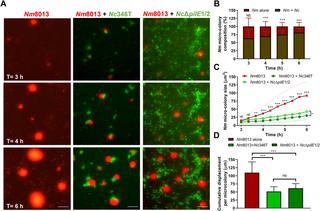PLoS Pathogens ( IF 5.5 ) Pub Date : 2020-03-24 , DOI: 10.1371/journal.ppat.1008372 Rafael Custodio 1 , Errin Johnson 1 , Guangyu Liu 1 , Christoph M Tang 1 , Rachel M Exley 1

|
It is increasingly being recognised that the interplay between commensal and pathogenic bacteria can dictate the outcome of infection. Consequently, there is a need to understand how commensals interact with their human host and influence pathogen behaviour at epithelial surfaces. Neisseria meningitidis, a leading cause of sepsis and meningitis, exclusively colonises the human nasopharynx and shares this niche with several other Neisseria species, including the commensal Neisseria cinerea. Here, we demonstrate that during adhesion to human epithelial cells N. cinerea co-localises with molecules that are also recruited by the meningococcus, and show that, similar to N. meningitidis, N. cinerea forms dynamic microcolonies on the cell surface in a Type four pilus (Tfp) dependent manner. Finally, we demonstrate that N. cinerea colocalises with N. meningitidis on the epithelial cell surface, limits the size and motility of meningococcal microcolonies, and impairs the effective colonisation of epithelial cells by the pathogen. Our data establish that commensal Neisseria can mimic and affect the behaviour of a pathogen on epithelial cell surfaces.
中文翻译:

共生灰葡萄球菌会损害脑膜炎奈瑟菌微菌落的发育并减少病原体在上皮细胞的定植。
人们越来越认识到共生菌和病原菌之间的相互作用可以决定感染的结果。因此,有必要了解共生体如何与其人类宿主相互作用并影响上皮表面的病原体行为。脑膜炎奈瑟菌是败血症和脑膜炎的主要原因,它专门定植于人类鼻咽部,并与其他几种奈瑟菌共享这一生态位,包括共生的灰奈瑟菌。在这里,我们证明了在粘附到人上皮细胞N的过程中。灰霉病菌与脑膜炎球菌也招募的分子共定位,并表明,与N .脑膜炎球菌灰霉病菌以四型菌毛 (Tfp) 依赖性方式在细胞表面形成动态微菌落。最后,我们证明N 。 cinerea与N共定位。上皮细胞表面的脑膜炎球菌,限制了脑膜炎球菌微菌落的大小和运动性,并损害病原体对上皮细胞的有效定植。我们的数据表明,共生奈瑟菌可以模仿并影响上皮细胞表面病原体的行为。











































 京公网安备 11010802027423号
京公网安备 11010802027423号